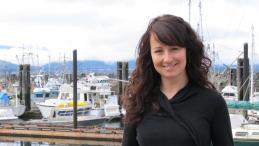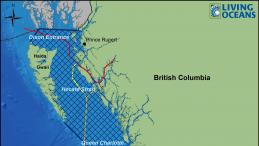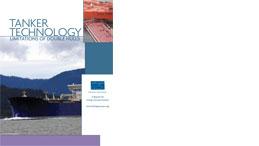Double-hulled oil tankers do not ensure protection against spills
SOINTULA, B.C.— A report by Living Oceans Society has identified numerous safety concerns associated with double-hull tankers, including corrosion and stress levels, that make the vessels an unsuitable panacea for oil spill prevention. The report, Tanker Technology: Limitations of Double Hulls, concludes that Enbridge’s pledge to use double-hulled tankers to service its controversial Northern Gateway Pipeline project will not ensure Canada’s Pacific North Coast is protected from catastrophic oil spills.
“Double hulls are one of the key safety measures of Enbridge’s Marine Plan for its pipeline project, but it’s an empty assurance that provides a false sense of security,” says Katie Terhune of Living Oceans Society. “In fact, double-hull tankers may actually increase the risk of oil spills.”
Although double-hulled tankers have the potential to reduce spill volume in minor groundings or low energy collisions, they are susceptible to a range of construction, maintenance and operation issues that make them more prone to leaks and failures including accelerated corrosion in their cargo tanks and high operating stress levels. Most importantly, double-hull tanker designs do not address human error, which is responsible for up to 80 percent of total oil spills worldwide.
“No safety measure can ever fully eliminate the risk of an oil spill,” says Terhune. “Tankers are run by people and people make mistakes. No technology can change that fact.”
If the Northern Gateway project is allowed to proceed, its twin-pipelines running between Alberta’s Tar Sands and Kitimat, B.C. would be serviced by 220 supertankers per year, each carrying up to two million barrels of crude oil through some of the most dangerous waters in the world. The few coastal tankers currently importing condensate to Kitimat are approximately 200 meters in length whereas the supertankers proposed by Enbridge are 350 meters long and can carry four times more cargo. When loaded they can take three kilometers and 15 minutes to come to a complete stop.
Additionally, the tankers will not be accompanied by escort tugs or BC Coast Pilots in the open waters of Hecate Straight, Dixon Entrance or Queen Charlotte Sound where wind speeds can reach 200 km/hr and waves higher than 25 meters can develop in less than eight hours. There will be no dedicated rescue tug on standby in the open waters if a tanker loses power or has a steering failure. Instead, Enbridge will send tugs from its Kitimat Marine Terminal with an estimated response time of 10-18 hours during which time a disabled tanker may drift ashore and ground.
Despite improvements in oil tanker regulation and technology, and a general decline in oil spills in recent years, accidents continue to occur. They are an inevitable part of shipping. In 2010 alone there were two major spills from double-hulled tankers: the Eagle Otome, with a coast pilot onboard, at Port Arthur, Texas and the Bunga Kelana 3 in the Strait of Singapore. Combined, the two tankers spilled 4.6 million liters of oil into the ocean.
Double-hulled or not, accidents happen. It would only take one spill to disrupt coastal communities, cultures and the environment for generations to come.
-30-
Contact Information
Katie Terhune, Energy Campaigner | ph: 250-973-6580
Background
Double-hull tankers have two layers of steel separating their cargo from the ocean opposed to only one layer in older single-hull ships. Both layers need to be punctured in order for a spill to occur. As of 2010, all tankers worldwide carrying oil in bulk need to be double hulled.
Although it is recognized that double-hull tankers are less likely to spill oil than single-hull tankers from minor groundings and low energy collisions, there are some incidents where a double-hull tanker may fair no better than its predecessor. Because of double-hull tankers’ complex design and structure, they are potentially more susceptible to problems of poor maintenance and operation. They are not a panacea for oil spill prevention.
Key Points
Double-hull tankers are a misleading safety measure. They are a meant to mitigate impacts from a tanker accident by reducing the amount of oil spilled rather than prevent an accident in the first place.
After the Exxon Valdez catastrophe in Alaska, the U.S. Coast Guard testified to Congress that even if the ship had been double hulled, the spill would have been reduced by only 60 percent at most, perhaps only 25 percent. Even under the best case scenario, 4.4 million gallons (16.7 million litres) of oil would have still spilled into the sea.
Double-hull tankers may actually increase the risk of oil spills. They are susceptible to a range of design, operation and maintenance issues. Examples include:
- Minimal operational experience The world double hull tanker fleet is young. There is no experience in whether double-hull designs will be effective in the later years of a vessel’s service life. Some first generation vessels already suffer defects in design.
- Extensive use of high tensile steel (HTS) HTS is cheap but increases flexibility and stress levels in a vessel. This increases the risk of fatigue cracks developing, ranging from nuisance cracks to cracks severe enough to cause leaks or structural failure.
- High operating stress loads Double-hull tankers operate with stress levels 30 percent higher than single-hull vessels, increasing the risk of buckling failure.
- Accelerated corrosion in cargo tanks Corrosion can lead to leaks and structural failure. The Oil Companies International Marine Forum – an industry group – identified accelerated corrosion as a serious concern. They found a tanker with 4.0mm corrosion pits after only 2 years in service. Average steel thicknesses of tank walls are only 20.0mm. Vessels are supposed to be in service for 20+ years.
- No requirements for leaked gas detection systems If a cargo leak develops inside the tanker, an explosive concentration of hydrocarbon vapour can build up, increasing the risk of a major explosion. Fires and explosions were the number one cause of tanker crew deaths in single-hull vessels.
- No requirement for cargo tank protective coatings in ships built before 2013 Once corrosion starts, it propagates quickly. Accelerated corrosion has been found in many tankers carrying crude oil.
- Poor stability during cargo loading and unloading There have been instances where vessels take on a sudden list during cargo operations. It can occur instantaneously during cargo and ballast loading and unloading.
- Hazardous and time-consuming inspections Inspectors do not always go in the cargo tanks. Corrosion can continue unchecked or simply go unnoticed. For example, the Erika was fully approved after an inspection yet she sank due to structural failure and spilled 19,800 tonnes of oil when she ran into bad weather off the coast of Brittany, France in 1999. The Erika was single hulled so had approximately 1/3 the surface area of a double-hull vessel to maintain and inspect.
80 percent of total oil discharges are caused by human errors. Regardless of advances in technology and regulation, humans will always make mistakes. Technology-based systems may reduce the severity of an oil spill once a human error is made, but they cannot interrupt the chain of events that may have caused the accident in the first place.
Oil spills have resulted from double-hull tanker accidents. Examples include:
- On May 25, 2010 the Malaysian-registered Bunga Kelana 3 collided with a bulk carrier in the Strait of Singapore. A ten meter gash was torn on the port (left) side of the ship, which then spilled an estimated 2,500 tonnes (2.9 million litres) of crude oil into the sea.
On January 23, 2010 the Eagle Otome, bound for Exxon Mobil Corporation’s refinery in Beaumont, Texas, collided with an outbound vessel towing two barges. The towing vessel tore open the side of the tanker, and an estimated 450,000 gallons (approximately 11,000 barrels or 1.7 million litres) of crude oil was spilled.



